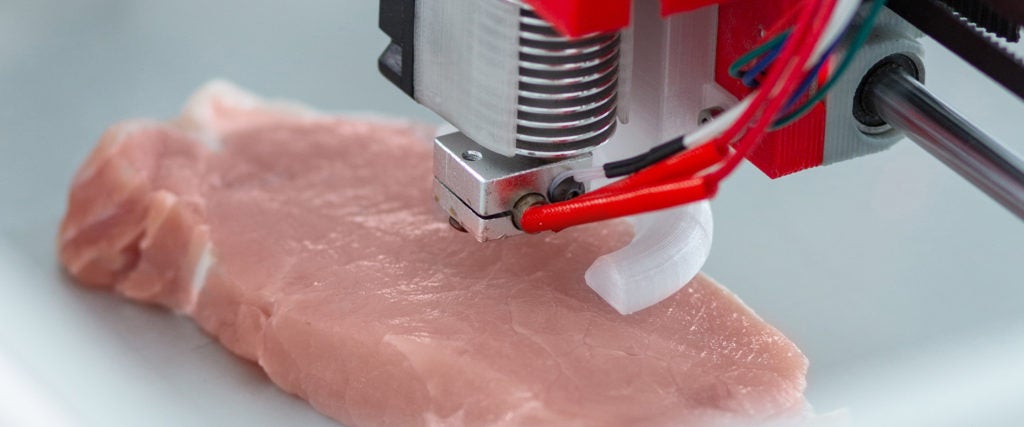Does “lab-grown” meat sound off-putting to you? Perhaps you’ll like “3D-printed” meat, instead.
While the fake meat market has nailed just about every conventional meat product, from burgers to stuffed Thanksgiving “turkeys,” we’ve yet to be offered something that looks like a real hunk of flesh — beef steaks, fillets of fish or chicken breasts are still largely only available in the form of the real thing. But recently, 3D-printed meat has been suggested as a possible solution.
A company called Redefine Meat announced at the end of June that they’d developed a realistic steak from an industrial scale food printer, while KFC announced last week that they’d been working with a Russian bioprinting company to produce chicken nuggets. If all those words strung together have you confused, you’re forgiven — here’s what we know so far about what any of that actually means.
So, like, what is 3D-printed meat?
The concept of 3D-printed meat has a few different interpretations. The one closest to being available to consumers is something being called “alt-steak,” created by Redefine Meat. Alt-steak won’t actually be steak at all, but instead (hopefully) a hyper-realistic plant-based faux-meat product. Unlike “lab-grown” meat, the alt-steak doesn’t utilize animal cells. The exact details of the steak and the machine that produces it are proprietary, but according to an article in Food Navigator, the alt-steak is created piece by piece, comprised of “alt-muscle, alt-fat and alt-blood.” As for what exactly that is, Redefine Meat has yet to say.
The KFC side of things, however, will use real chicken cells. However, the actual harm to chickens will be far less than the real thing. Though the cells will originate from an actual chicken, these cells can be duplicated and used to create far more nuggets than one chicken could provide. In a press release, KFC wrote that alongside Russia’s 3D Bioprinting Solutions, they are “developing additive bioprinting technology using chicken cells and plant material, allowing it to reproduce the taste and texture of chicken meat almost without involving animals in the process.”
Like Redefine Meat, KFC is being relatively quiet about the exact ingredients, but it sounds as though their 3D-printed nuggets will be closer to real meat.
But what even is a 3D food printer?
Again, the creators are quiet about this. I quite honestly couldn’t tell ya. Redefine Meat does have a picture of the printer here (assuming that’s not just a suitably Star Trek-ish artist’s impression).
What exactly are the benefits, assuming I’m even willing to eat it?
Both Redefine Meat and KFC are claiming their products utilize dramatically fewer resources than the real thing. Redefine Meat states that their product has “95 percent smaller environmental impact, no cholesterol and is more affordable compared to animal meat.” Meanwhile, KFC states, “The technology of growing meat from cells has minimal negative impact on the environment, allowing energy consumption to be cut by more than half, greenhouse gas emissions to be reduced 25 fold and 100 times less land to be used than traditional farm-based meat production.”
Further, they believe that cell-based bioprinted nuggets are a far cleaner, more ethical product.
When can I try it, hypothetically?
Redefine Meat has said these steaks will be available in select high-end restaurants in the U.S. by the end of the year. How they perform there will dictate if and when alt-steaks become available to the average consumer in grocery stores. If you live in Moscow, you might be able to try KFC’s bio-nugs at the chain later this year, as well. Like alt-steaks, how they perform in these trials will determine if and when they hit KFCs elsewhere.
So all this could actually become a real thing, huh?
Whether it’s lab-grown, 3D-printed or just made by mashing some black beans together in the shape of a patty, meat alternatives are at least going to be a part of the future, if not eventually our primary source of meat, entirely. As decent as the options for vegans and vegetarians might already be, it’s hard to satisfy the craving for a juicy cut of steak or those 11 herbs and spices that coat a piece of KFC fried chicken.

